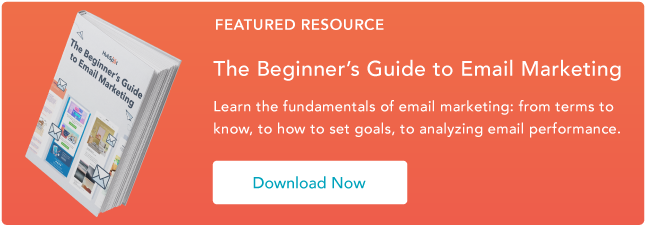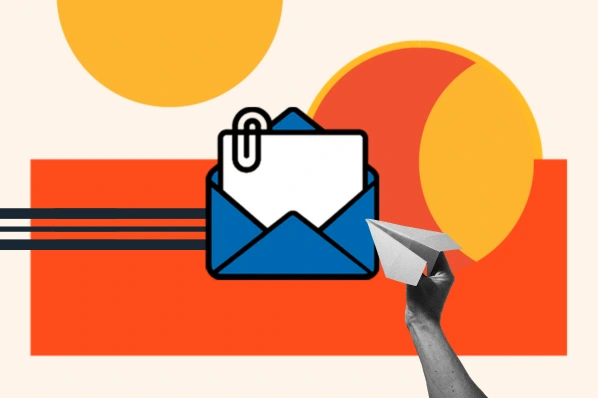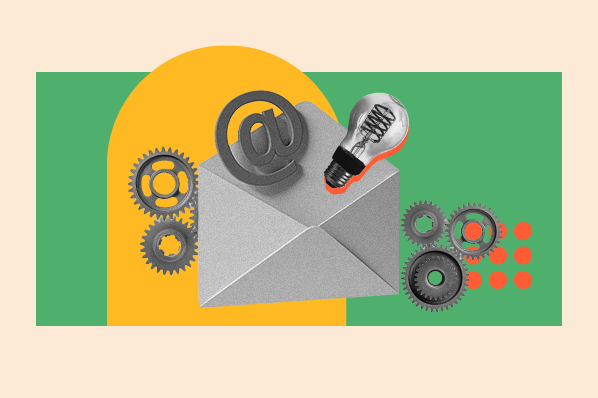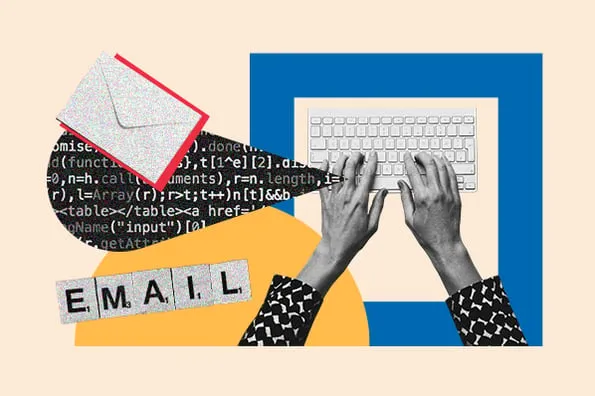Even as new marketing channels crop up, email marketing continues to be an effective way to generate leads and convert more prospects for your business.

According to a HubSpot survey, 94% of marketers find email marketing effective for reaching their business goals.
To get the most out of your email marketing strategy, check out these best practices.
Table of Contents
Email Marketing Best Practices
- Don't purchase contact lists.
- Avoid using 'No-Reply' in the sender's email address.
- Stick to fewer than three typefaces.
- Optimize the email's preview text.
- Include an email signature.
- Clean your mailing list regularly.
- Keep the main message and call-to-action above the fold.
- Personalize the email greeting.
- Keep your email between 500 and 650 pixels wide.
- A/B test your subject lines and calls to action.
- Include your logo.
- Name the offer in your subject line.
- Allow recipients to subscribe to your newsletter.
- Write compelling (but concise) subject lines.
- Create automated emails for opt-ins.
- Closely tie emails to landing pages.
- Conduct a five-second test.
- Make it personal.
- Include a clear CTA.
- Follow up.
17 Inbound Email Marketing Best Practices
1. Don't purchase contact lists.
This first tip should come as no surprise, but given the General Data Protection Regulation (GDPR), it bears repeating.
Email campaigns depend on a healthy open rate. If you're contacting people whose information you bought — rather than earned from a previous interaction — you‘ll quickly see your emails’ performance drop.
The GDPR also requires each European recipient's consent before you contact them. Purchased email lists usually do not come with that consent.
.png)
A Beginner's Guide to Email Marketing
How to execute and measure successful email marketing campaigns
- Growing an email list.
- Remaining CAN-SPAM compliant.
- Using email automation.
- Segmenting your audience.
Download Free
All fields are required.
.png)
For help reaching your target audience, consider Versium Reach — a platform for B2B marketers that allows you to own data on your target audience across multiple marketing channels.
2. Avoid using ‘No-Reply’ in the sender's email address.
Have you heard of CAN-SPAM? This long-standing legislation is a popular and important guideline for all email marketers in the U.S.
One major rule in CAN-SPAM is to never use the words "no reply,“ or a similar phrase, as your email sender's name (for example, ”noreply@yourcompany.com").
“No reply” in an email message prevents recipients from responding and even opting out of further emails, which CAN-SPAM protects their right to do so at any time.
Instead, have your automated emails come from a first name (for example, jamie@mycompany.com). Your customers are much more likely to open emails if they know a human being wrote them. Plus, it keeps you compliant with email regulations.
3. Stick to fewer than three typefaces.
The less clutter you have in your email, the more conversions you'll get.
Don't junk up your message with more than two fonts or typefaces, as that can distract readers and ruin your email’s visual appeal.
In the email example below from recruiting SaaS company Greenhouse, the company sticks to just two fonts.
Not only does this make it easy to read, but readers can focus on the context of the email rather than get distracted by the styling.
In addition, use web-safe fonts with sizes between 10-point and 12-point. This ensures your email will be legible on all readers and devices.
4. Optimize the email's preview text.
If you subscribe to any newsletter, you’ve likely seen a message like this at the top of your email: “Email not displaying correctly? Click here.”
While it's a helpful message, keeping it in the preview text of your email (also known as the preheader) can significantly impact your email’s open rate.
Firstly, because you’re telling recipients, “Hey, this email might not work." Secondly, it doesn’t provide any insight into what the email is about.
Your preview text should supplement your subject line by adding details to capture your audience’s attention and encourage them to open.
By default, preview text pulls in the first several words of the email body and displays it next to the subject line before the person opens it.
The problem is that custom email templates often stick with conditional statements like “Can't see images?” or “Not displaying correctly?” at the top banner, allowing it to slip right into the preview when it goes out.
As a rule of thumb, always write a custom preheader that teases what your email will offer.
(If you're having trouble writing your preview text or emails as a whole, this video can help you harness the power of AI for the purpose of email creation.)
Pro tip: HubSpot users can fix this problem by customizing the preview text themselves in the backend of their email marketing newsletter.
5. Include an email signature.
Even if your newsletter is technically being sent to your contacts on behalf of the company, rather than an individual, the email should include the signature of a specific person.
In a 2020 State of Business Email Marketing study, 62% of marketers said they use email signatures to increase visibility around their branding.
When you consider that every email sent on behalf of your company is another branding opportunity, it makes sense to include a signature.
Your email signature should include some sort of CTA, whether that’s a link to your website, social media, or a specific landing page.
Another reason you should include your email signature is that it’s a touch of personalization.
People are naturally more inclined to read an email if they know it came from a human being, not just a collective marketing team. Your email signature is your ticket to their attention.
Want a quick way to make a beautiful email signature? Use HubSpot's Email Signature Generator. We also have an Out-of-Office Email Generator to make your response to incoming messages just as delightful.
6. Clean your mailing list regularly.
Some of your email contacts might not opt out of your email campaign but will still never open your emails.
According to a HubSpot survey, over 32% of marketers say low open rates are one of their biggest challenges with their email marketing strategy.
Emailing as many people as possible is tempting, but keeping your least-engaged recipients on your mailing list can kill your open rate.
People who never open emails make your campaign look worse since you‘re not analyzing the campaign’s quality against your most loyal recipients.
Review your list of subscribers who haven’t engaged with your emails over a certain period, and remove them regularly.
This gives you a more accurate email open rate and keeps your email campaign clean of people no longer interested in hearing from you.
You can also implement a workflow in which they’re gradually moved to a less frequent email list based on activity.
For instance, say you have a daily newsletter. You could implement a workflow in which subscribers who do not open your email in two consecutive weeks are moved to the weekly email.
Then, those subscribers could be moved to the monthly newsletter if they don’t open four consecutive emails. And so on.
It keeps you from bombarding your subscribers with emails they’re not interested in, all while keeping your list clean.
.png)
A Beginner's Guide to Email Marketing
How to execute and measure successful email marketing campaigns
- Growing an email list.
- Remaining CAN-SPAM compliant.
- Using email automation.
- Segmenting your audience.
Download Free
All fields are required.
.png)
7. Keep the main message and call-to-action above the fold.
Above the fold refers to the information visible to the reader before they scroll down.
Even though recent research suggests that consumers scroll more than they used to — because of social media and vertical timelines — above-the-fold content still gets the most attention when considering that people don’t have long attention spans.
According to a 2022 report from Litmus, people spend an average of nine seconds looking at an email.
With this in mind, place your main message and CTA above the fold. It’s the first thing your recipients will see once they open your email, increasing your conversion rate.
You can also run an A/B test first to validate the hypothesis and see if it works for your emails.
8. Personalize the email greeting.
How often do you read emails that begin with “Dear Member?”
You might segment your email audiences by their customer type (member, subscriber, user, etc.), but it shouldn't be the first thing recipients see in your company messages.
Personalizing the greeting of your emails with your contacts‘ first names grabs each reader’s attention. For HubSpot users, this is called a personalization token, and creating one looks like this:
Then, the address line of your email would automatically produce the contact's first name by fetching this personalization token in the email's HTML, like this: Hi, !
Don‘t worry; personalizing an email’s greeting line with 50 recipients‘ names doesn’t mean you'll have to manually write and send 50 different emails from now on.
Many email marketing tools today allow you to configure the greeting of your email campaign so that it automatically sends with the name of the people on your contact list — so everyone is getting a personal version of the same message.
9. Keep your email around 500 to 650 pixels wide.
If your email template is wider than 650 pixels, your email won’t show up correctly and will require users to scroll horizontally to read the full email.
This is a pain, to say the least, and will likely affect your conversion, especially when many users read emails on mobile.
Nearly 30% of marketers say that optimizing emails for mobile is one of the most effective strategies for increasing the click-through rate (CTR), according to data from HubSpot.
Having your template fit within the standard format will make for easier readability, better conversions, and an overall better user experience.
10. A/B your subject lines and calls to action.
If you can‘t seem to increase your email’s open and click-through rates, a couple of things might be wrong: You‘re not emailing the right people (if you’re buying your contact list, see the first tip at the top of this blog post), or the content needs to be improved.
To start, focus on the latter, and conduct an A/B test. 18% of marketers have found success with increasing click-through rates when they used A/B testing.
A/B tests can be used to improve almost any of your digital marketing content.
In an email, this test splits your recipients into two groups: Group A receives the regular newsletter, while Group B receives the newsletter with a specific variation. The variation can be anything from a different subject to another CTA.
This variation tests to see if your audience would be more or less likely to take an action based on that element.
HubSpot Marketing Hub users can conduct email A/B tests on anything from the subject line to the call-to-action (CTA) inside it.
For example, you might change the color of your CTA from red to green to see if your email‘s clickthrough rate increases. If it does, the test indicates that you should change all of your emails’ CTA color to green from now on.
11. Include your logo.
Logos are essential when it comes to emails.

A 2021 study by Red Sift and Entrust found that logos positively impact email engagement as well as brand recall.
The study found that when businesses include a logo in their emails, open rates increased by 21%.
Brand recall increased by 18% after a five-second exposure when including a logo in the email. Consumer confidence in the legitimacy of an email also increased by 90%.
With this in mind, add your logo to your email design to ensure that it’s always included.
12. Name the offer in your subject line.
You can drastically increase your open rates by including an incentive in your subject line.
31% of marketers say that emails with special offers or promotions have the highest open rate, and 30.7% of marketers say these emails also have the highest click-through rate.
If you’re running a promotion, use incentive-focused subject lines like “Free shipping when you spend $25 or more” or "Receive a free iPad with a demo.”
Here's an example of an email with an enticing subject line and warm, welcoming body copy. The subject line for this email from Elementor says, “Up to 50% off when upgrading!”
However, be careful not to overwhelm your readers with savings- or product-related emails.
Customer loyalty starts with casual industry insights — only after nurturing should you start introducing offers.
13. Allow recipients to subscribe to your newsletter.
You might be thinking, "Wait, if they received the email to begin with, shouldn’t they have already subscribed?"
Usually, yes. Therefore, adding a “Subscribe” button to your email doesn’t help those who’ve already agreed to receive your emails.
But great content is shareable content, and if your current subscribers are forwarding your emails to their friends and colleagues, you’ll want to help them subscribe, too.
.png)
A Beginner's Guide to Email Marketing
How to execute and measure successful email marketing campaigns
- Growing an email list.
- Remaining CAN-SPAM compliant.
- Using email automation.
- Segmenting your audience.
Download Free
All fields are required.
.png)
Add a small but visible CTA that allows the recipient to subscribe to the newsletter if they received this email from someone else.
This email newsletter called Contentment is a great example of how to include a sign-up CTA in your email without distracting from the rest of the content:
But remember, because your newsletter should already be driving another action, such as downloading an ebook or signing up for a webinar, make sure this “Subscribe” button doesn't distract or confuse users, weakening your main campaign goal in the process.
14. Write compelling (but concise) subject lines.
A good subject line should contain between 30 and 50 characters, including spaces. The reason why you do this is that email providers often cut off subject lines that go beyond this length.
Your email subject line should also create a sense of urgency while giving readers some indication of what to expect once they open the email.

15. Create automated emails for opt-ins.
Be prepared for your readers to forget they opted in.
Set up an automated email flow that reminds people they opted into your email database. The auto-responder should be sent out one day, five days, and 10 days after the person subscribes.
Each automated email should also include additional content or bonus material to reward the reader for opting into the newsletter — or your readers might not feel they have enough incentive to actually stay on your list.
16. Closely tie emails to landing pages.
If you’re promoting a specific landing page in your email, the landing page should match the email in terms of headline, copy, and content.
The look and feel of your landing page should also match the email to help create consistency, which goes a long way toward earning a customer's trust.
Also, make sure you‘re using tracking tools to see which emails and landing pages performed the best so you can keep sending what’s working.
17. Conduct a five-second test.
Send a copy of the email to a friend or colleague. Can they quickly tell what your CTA is? If so, you’re ready to hit send. If not, figure out how you can tweak your subject line. Or, if there’s a different landing page, you should link to it.
3 Outbound Email Best Practices
If you’re sending emails for lead generation — for example, in a sales position — then there are a few more outbound email best practices to employ.
Following these best practices ensures you’re effectively forming strong connections that can lead to potential business opportunities.
1. Make it personal.
Sending an outbound email isn’t too different from sending a marketing email.
You should still be personal, but even more so when you know your email is only being read by the receiver.
Start by letting them know how you know them. Have you already connected on Twitter or in a Slack group? Is this a completely cold email? Figure out where you stand so you know how best to personalize the greeting and message.
2. Include a clear CTA.
What do you want the receiver to do next? Set up a call? Book a demo? Make your CTA clear from the beginning so there isn’t any question about what the purpose of your email is.
Also, don’t close with a vague, open-ended message like, “Let me know what you think!” Instead, offer a clear statement or question, such as, “When is a good time to set up a call?” Being direct and clear helps limit the time the receiver spends figuring out what you want.
3. Follow up.
Follow up when necessary, but don’t bombard the receiver with a million follow-up emails.
Be aware of the typical response time from people in your industry or people you reach out to. Anywhere from two days to one week is a reasonable amount of time between sending your first email and sending a follow-up.
Getting Started
There are a lot of new tools at a marketer's disposal that are getting attention these days. But email marketing has stood the test of time regarding its influence on your users.
This old, reliable, and faithful tool can ensure you get the most out of your marketing initiatives if you follow these effective email best practices.
Editor's Note: This post was originally published in June 2019 and has been updated for comprehensiveness.
![→ Download Now: The Beginner's Guide to Email Marketing [Free Ebook]](https://no-cache.hubspot.com/cta/default/53/53e8428a-29a5-4225-a6ea-bca8ef991c19.png)







![Creating an HTML Email: The Design Guide You Need [+ Free Templates]](https://www.hubspot.com/hubfs/html%20design.png)


![30 Brilliant Marketing Email Campaign Examples [+ Template]](https://www.hubspot.com/hubfs/email-marketing-examples_29.webp)